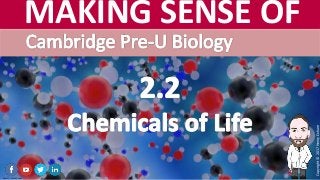
Cambridge Pre-U Biology - 2.2 Chemicals of Life
- 1. MAKING SENSE OF Icons CC – The Pink Group Copyright©2017HenryExham
- 2. Copyright © 2015 Henry Exham 2 • The basic unit of life is a cell. • To really understand how it works you need to know what it is made from. • In this topic you will learn about the most important molecules that are used to make cells and other important structures in biology. • This is the chemistry of life!
- 3. MAKING SENSE OFMAKING SENSE OF Water Lipids Carbohydrates Proteins Nucleic Acids 3
- 4. Copyright © 2015 Henry Exham 4 • Life on this planet is dependent on water. • It is the medium in which reactions take place and therefore what is contained inside cells. • It is one of the simplest molecules we know but it has some incredible properties which living organisms have been able to take advantage of.
- 5. Copyright © 2015 Henry Exham a) Describe the chemical and physical properties of water and explain the biological significance of these properties.
- 6. Copyright © 2015 Henry Exham 6 • H2O • Seems very basic but due to the electrons it means water is what we call a polar molecule. • This means it is slightly charged. • The oxygen is a little bit negative and the hydrogen's are a little positive. • This is shown using the letter delta (δ). δ+ δ+ δ- O HH
- 7. Copyright © 2015 Henry Exham 7 • This may not seem like such a big deal but it means that water molecules can interact with each other by forming hydrogen bonds. δ+ δ+ δ- δ+δ+ δ- δ+δ+ δ- δ+δ+ δ- δ+δ+ δ- δ+δ+ δ- δ+δ+ δ-
- 8. Copyright © 2015 Henry Exham 8 • The hydrogen bonds give water some incredible properties which many forms of life depend on. • These are outlined on the following slides.
- 9. Copyright © 2015 Henry Exham 9 1. Water is a polar solvent – This means many substances will dissolve in it. Therefore chemical reactions can happen in it and it can be used for transport. – In humans the blood plasma is mostly water. – In plants water is used to transport minerals and sugars in the xylem and phloem.
- 10. Copyright © 2015 Henry Exham 10 2. Water has a high specific heat capacity – Large bodies of water vary only a little throughout the year as it takes a lot of energy to heat up water due to the many hydrogen bonds. – This makes it a very stable environment for organisms to live in.
- 11. Copyright © 2015 Henry Exham 11 3. Water has a high latent heat of vaporisation – This means it takes a lot of energy to vaporise water. – This is important for sweating as when the sweat evaporates from the skin it uses a lot of heat energy. – This cools the body down.
- 12. Copyright © 2015 Henry Exham 12 4. Cohesion - Surface tension – The hydrogen bonds mean that the water at the surface holds together like a skin. – This means organisms can live on the surface easily. – It also helps water to be transported up the xylem vessels in plants.
- 13. Copyright © 2015 Henry Exham 13 5. Maximum density at 4oC – As water cools below 4oC the density decreases because the hydrogen bonding becomes more regular and keeps the water molecules further apart. – This means that when it freezes, the ice floats on the surface. – This provides a habitat on top of water but also maintains the habitat for the organisms in the water.
- 14. MAKING SENSE OFMAKING SENSE OF Water Lipids Carbohydrates Proteins Nucleic Acids 14
- 15. Copyright © 2015 Henry Exham 15 • Lipids are used for many different functions in living organisms. • They are used as an energy store, to make cell membranes, insulation, protection and water proofing. • They are made of carbon, hydrogen and oxygen like carbohydrates, but have a much lower proportion of oxygen.
- 16. Copyright © 2015 Henry Exham b) Describe the structures and properties of triglycerides and phospholipids and explain how these are related to their roles in living organisms. c) Describe the formation and breakage of ester bonds such as those found in triglycerides. d) Distinguish between saturated and unsaturated fatty acids.
- 17. Copyright © 2015 Henry Exham 17 • Fats and oils are groups of lipids. • Fats are solid at room temperature when oils are liquid. • They are made from two types of molecules: FATTY ACIDSGLYCEROL C H OH C H OH C H OH HH C H H C H H C H H H C H H C H H C H H C H H C H H C H H C OH O
- 18. Copyright © 2015 Henry Exham To download the whole presentation visit www.MrExham.com
- 19. This PowerPoint is protected under copyright. It is designed for educational use. Either personal study or to be presented to a class. It may be edited or duplicated for these purposes only. It must not be shared or distributed online in any format. Some images used are under a separate creative commons license, these are clearly marked. Copyright © 2016 Henry Exham Brought to you by MrExham.com
